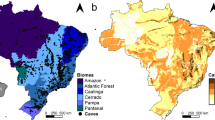Abstract
Representatives of the subgenus Coptoformica build composite aboveground nests in much the same manner as red wood ants do. However, despite the superficial similarity, Coptoformica nests show a number of substantial differences that impact on the way in which ants use the nest. The aboveground part of a Formica (Coptoformica) exsecta nest consists of the temporary layer, the outer crust layer, the mound, and the intermediate layer. The material of all the layers includes soil and fragments of plants (picked up or excised), the relative proportion of the two components differing among the layers. The thick, soil-rich crust layer acts as armature and allows a variety of anthill shapes. The intermediate layer and the upper part of the mound harbor quite a few large chambers. Building material is often transferred from nest to nest. On the whole, F. exsecta nests are plastic and movable, which facilitates the activity of these ants in ecotone biotopes.
Similar content being viewed by others
References
Arnoldi, K.V., Grimalsky, V.I., Demchenko, A.V., Dmitrienko, V.K., Zakharov, A.A., et al., “Studying the Ecology of Ants (Methods),” in Ants and Forest Protection. Proceedings of the VI All-Union Myrmecological Symposium (Tartu, 1997), pp. 155–171.
Dlussky, G.M., Ants of the Genus Formica (Nauka, Moscow, 1967) [in Russian].
Dmitrienko, V.K. and Petrenko, E.S., The Ants of Taiga Biocenoses of Siberia (SO Nauka, Novosibirsk, 1976) [in Russian].
Goryunov, D.N., “Forms of Colony Organization in the Ants Formica exsecta,” Uspekhi Sovremennoi Biologii 127 (127), 203–208 (2007).
Goryunov, D.N., “Leaf Cutting by the Ants Formica exsecta,” in Abstracts of the V All-Russia Conference on Animal Behavior (Moscow, 2012).
Goryunov, D.N., “Seasonal Migrations in the Ants Formica exsecta,” in Ants and Forest Protection. Proceedings of the XIII All-Russia Myrmecological Symposium (Nizhny Novgorod, 2009), pp. 184–186.
Holldobler, B. and Wilson, E.O., The Superorganism (W.W. Norton & Co., New York, London, 2009).
Kloft, W., “Zur Nestbautätigkeit der Roten Waldameise,” Waldhygiene 3 (3/4), 94–98 (1959).
Pisarski, B., “La Structure des Colonies Polycaliques de Formica (Coptoformica) exsecta Nyl.,” Ecologia Polska 20 (20), 111–116 (1972).
Sudd, J.H., “The Excavation of Soil by Ants,” Z. Tierpsychol. 26, 256–276 (1969).
Tschinkel, W.R., “Subterranean Ant Nests: Trace Fossils Past and Future? Palaeogeography, Palaeoclimatology, Palaeoecology 192, 321–333 (2003).
Zakharov, A.A., Community Organization in Ants (Nauka, Moscow, 1991) [in Russian].
Zakharov, A.A. and Goryunov, D.N., “General Methods for Field Ecological Studies,” in Ants and Forest Protection. Proceedings of the XIII All-Russia Myrmecological Symposium (Nizhny Novgorod, 2009), pp. 247–255.
Author information
Authors and Affiliations
Corresponding author
Additional information
Original Russian Text © D.N. Goryunov, 2015, published in Zoologicheskii Zhurnal, 2015, Vol. 94, No. 10, pp. 1132–1137.
Rights and permissions
About this article
Cite this article
Goryunov, D.N. Nest-building in ants Formica exsecta (Hymenoptera, Formicidae). Entmol. Rev. 95, 953–958 (2015). https://doi.org/10.1134/S0013873815080035
Received:
Published:
Issue Date:
DOI: https://doi.org/10.1134/S0013873815080035




